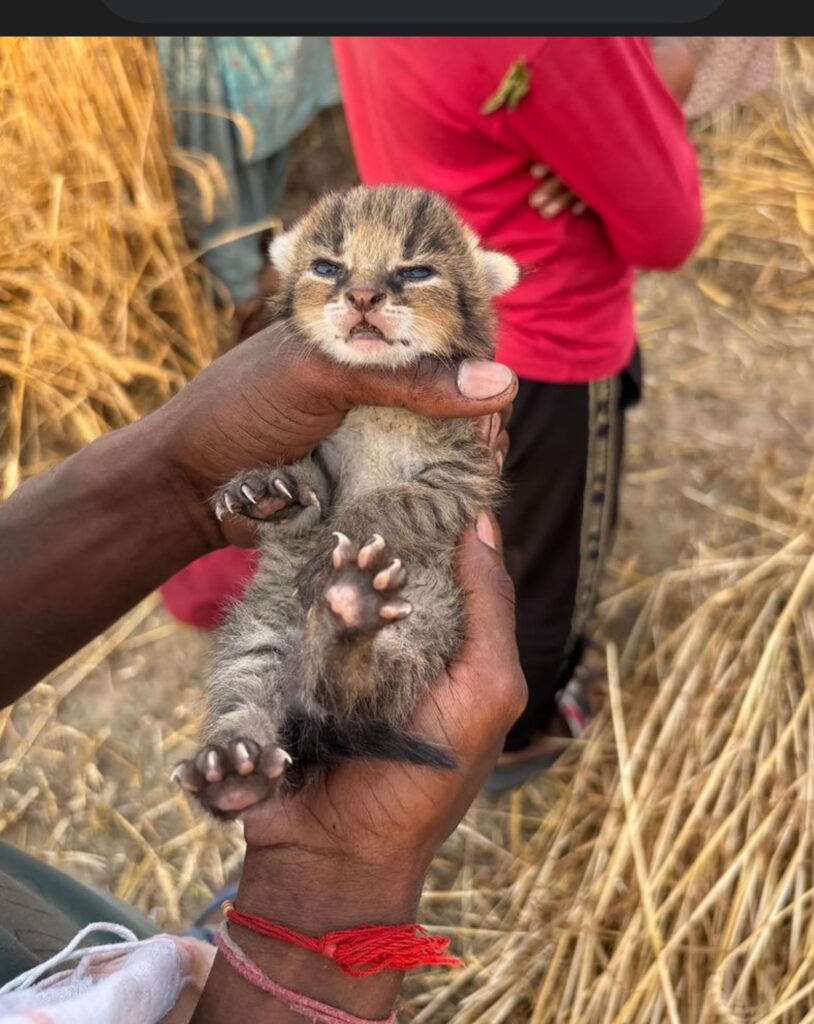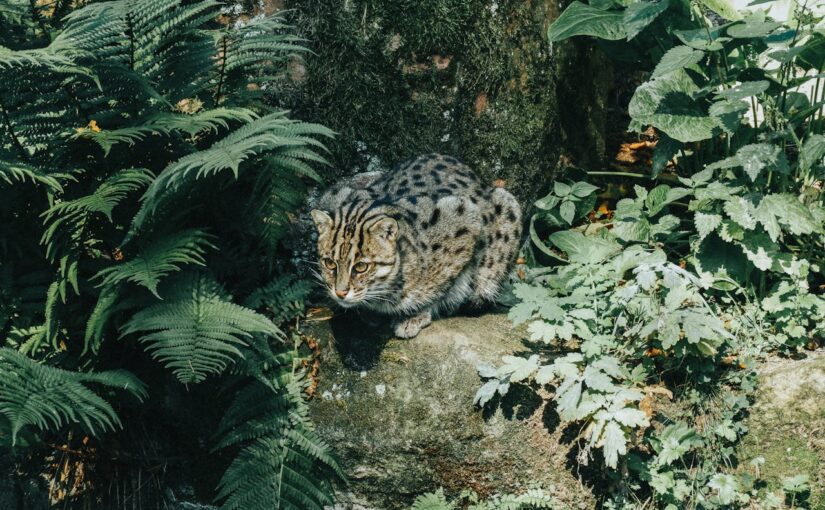In May 2025, near the tranquil edges of a farm bordering a dense forest in Punjab’s Hoshiarpur district, an extraordinary event sent waves of excitement through India’s wildlife community. Three diminutive, spotted cubs, tentatively identified as the endangered Indian Fishing Cat, were discovered nestled near a watercourse. This was a setting that seemed entirely unexpected for this elusive species. News of the sighting quickly captured environmental circles and reached far beyond. The event rekindled hope for conservationists who often work in the shadow of species decline. The rarity of such an encounter in Punjab, which is far distant from the cat’s better-known strongholds, has sparked both celebration and debate among experts and enthusiasts alike.
Meet the Indian Fishing Cat
The Indian Fishing Cat, scientifically named Prionailurus viverrinus, is a striking and specialized feline renowned for its affinity for water. It stands apart from other wild cats in India because of its muscular, stocky body, short limbs, and distinctive spotted grayish coat. The coat is adorned with bold, dark stripes and spots. The most distinguishing features are its partially webbed paws. These enable it to swim with remarkable agility and to adeptly snatch slippery fish from shallow waters.
Unlike the stealthy big cats of the central plateaus or the leopards endemic to the mountain forests, the Fishing Cat lives a life intimately tied to wetlands. Its favored haunts include dense reed beds, marshes, riverbanks, mangroves, and shallow lakes. The species has a penchant for environments teeming with fish and amphibians. Its diet is vividly aquatic. Fish comprise the bulk, supplemented by amphibians, crustaceans, snails, and sometimes small birds and mammals. Though the species’ core territory lies across South and Southeast Asia, stretching through the Sunderbans of West Bengal and the mangroves of Odisha and Bangladesh, it is unevenly distributed. Populations are now highly fragmented due to habitat pressures.
Read more: The Fishing Cat: The Swimmer of the Cat Family
Why the Fishing Cat Faces Extinction Risks
The Indian Fishing Cat’s allure is matched only by the magnitude of threats stalking it. Classified as Vulnerable on the IUCN Red List, and Endangered under the Wildlife (Protection) Act of India, the species faces a precarious future. A steady and troubling decline, estimated at 30 percent over the past 15 years, traces its path through areas where wetlands once flourished but are now diminished by unchecked urbanization, agricultural expansion, and pollution. In some regions, such as Andhra Pradesh, mangrove forests are converted to aquaculture. In others, like West Bengal, local hostility and poaching escalate pressures.
Beyond direct habitat loss, the Fishing Cat is also imperiled by misidentification. Rural communities occasionally mistake it for more notorious predators or even tiger cubs, which leads to unnecessary persecution. Human-wildlife conflict over fish stocks, a key resource for both the cats and local fisherfolk, further deepens these challenges. Despite legal protections, which include severe penalties for poaching or harming the cats, the species’ survival depends heavily on safeguarding the intricate tapestry of wetlands and riversides it calls home.
Encouragingly, a growing coalition of conservation organizations, notably WWF India and regional NGOs, has mounted efforts aimed at wetland preservation, community education, and direct monitoring. In West Bengal and Odisha, the Fishing Cat Project, led by conservationist Tiasa Adhya, has pioneered community-driven strategies and citizen science networks to both monitor and protect these elusive felines. This model is one that advocates hope will spread to other regions.
Inside the Hoshiarpur sighting
The events that unfolded in Hoshiarpur this past May began in quiet drama. A farmer tending his borderland fields near the Rupnagar district junction stumbled upon three kittens not far from a stream. Their bold, dappled coats and semi-aquatic habits raised immediate suspicions that these could be the highly sought-after Fishing Cat cubs. This was the first such report in Punjab in nearly a decade.

Wildlife officials and local conservationists were quickly notified. Discretion was exercised, with environmental groups deliberately holding off on public announcements to give the animals a chance to find safety. As the Punjab Forest Department moved in to investigate, the story piqued national curiosity. For the Fishing Cat, Punjab is off the beaten path. The region lacks the expansive wetlands the species typically favors, and this sparked intriguing hypotheses. Were the cats expanding their territory due to climate shifts, habitat loss elsewhere, or were they remnants of a hidden, overlooked population?
Yet, just as the excitement peaked, controversies surfaced. Several leading carnivore experts, including Dr. Shomita Mukherjee and Tiasa Adhya, advised caution. They highlighted the persistent challenge of distinguishing Fishing Cats from similarly marked Jungle Cats, especially in their juvenile phase. Photos reviewed by these experts suggested, in some cases, that what had been identified as Fishing Cats might actually have been Jungle Cat kittens, a species far more common locally. This uncertainty has underscored the complexity and necessity of rigorous scientific identification. It also highlights gaps in training and awareness across frontline staff.
What this means for conservation
If validated, the Hoshiarpur sighting could mark the emergence of either a newly established population or an isolated survivor group. This would compel a rethink of the species’ range and conservation needs in northern India. Already, the case has kindled renewed calls for expanded wetland conservation, not just in the acknowledged bastions of West Bengal and Odisha, but throughout Punjab and the broader north. Such discoveries, regardless of their final classification, underscore how little is yet known about small wild cat populations, especially in areas subjected to rapid agricultural and urban shifts.
Grassroots involvement could become a catalyst for change. Citizen science initiatives, where locals and nature enthusiasts report and help monitor rare wildlife, are proving vital. Accurate documentation and photographic evidence, coupled with capacity-building for field staff, could ease the risk of misidentification while empowering communities as conservation guardians. As awareness spreads, so might support for legislation that safeguards Punjab’s overlooked streams, marshes, and distant wetland corners.
Moreover, public fascination with rare species often translates into greater funding for wetland heroics. This includes restoration of natural marshes, strengthened protections against encroachment, and programs that educate rural and urban audiences alike about India’s unique fauna and the critical habitats they need.
Voices from the field
Such sightings invariably ignite the imaginations of those who work closest to the land. A local wildlife photographer, recalling the event, might describe the thrill of tracking paw prints through dew-drenched grass at sunrise. The heart pounds with hope for that one elusive photograph. “For hours, I waited near the water’s edge, listening to faint rustles. It was a reminder that, even now, nature retains its secrets,” one might say.
Researchers like Tiasa Adhya continually emphasize that each confirmed Fishing Cat sighting serves as a clarion call for smarter and more inclusive conservation. “Recognizing wetlands beyond established reserves as critical habitats, and collaborating with people who live along their banks, is the only way we’ll secure a future for these remarkable cats,” she argues. Her experiences in the Sunderbans and Odisha demonstrate how local knowledge and direct involvement can transform both attitudes and outcomes for threatened wildlife.
For Punjab’s farming communities, the possibility of sharing the land with such a rare feline may at first invoke caution. However, it also fosters pride. Tales of past encounters, sometimes retold as folklore, now gain new relevance as the state finds itself at the forefront of conservation conversations.
How to help and what comes next
Encounters like those in Hoshiarpur offer hope to wildlife lovers everywhere. However, hope alone cannot sustain populations against the onslaught of modern threats. Everyone, from bloggers to daily commuters, from policymakers to schoolchildren, has a role to play. Supporting conservation organizations, reporting sightings responsibly, and advocating for the protection of local wetlands all contribute to a future where the Indian Fishing Cat and a multitude of wetland species might thrive once more.
The story unfolding in Punjab is far from over. Whether future surveys confirm the identity of those cubs or not, their discovery has already served its most important purpose. The event rekindled interest, inspired vigilance, and showed that nature’s enduring resilience is matched only by humanity’s capacity to care. With expanded knowledge, sharper awareness, and shared commitment, the rare ripples of excitement brought by those spotted cubs in Hoshiarpur could multiply into a tide of conservation success for India’s vanishing wetlands and their charismatic hunters.
Photo by Davor Eres.
